Unveiling Nighttime Spies: Glint Detection for Home Security Professionals
Glint detection, utilizing infrared cameras and polynomial filters, identifies hidden cameras in hom…….
Glint detection, utilizing infrared cameras and polynomial filters, identifies hidden cameras in homes by analyzing light patterns and specular reflections, especially in low-light areas. Strategically placing cameras near windows or reflective surfaces (best hidden camera locations) enhances home security without invading privacy. Security professionals use advanced lighting techniques and smart home device knowledge to detect covert recording devices, complementing traditional scanning methods with alternative viewpoints like shadows or heat signatures for comprehensive protection.
In today’s digital era, enhancing home security has become paramount. One subtle yet potent tool in this arsenal is glint detection, especially during nighttime. This article delves into the intricacies of camera lens glint detection, highlighting its significance in strengthening residential security. We explore best practices for home security professionals and provide techniques and tools to uncover hidden cameras, focusing on optimal placement for maximum effectiveness. Remember that staying ahead of potential threats is key, and understanding glint detection can make all the difference.
- Understanding Glint Detection and Its Importance in Nighttime Security
- Identifying Hidden Cameras: Best Practices for Home Security Professionals
- Detecting Glints: Techniques and Tools for Uncovering Secret Cameras at Home
Understanding Glint Detection and Its Importance in Nighttime Security
Glint detection is a critical component of nighttime security systems, especially in home security applications. It refers to the process of identifying and distinguishing subtle light reflections from hidden camera lenses, which can provide valuable insights into potential threats or suspicious activities that occur in low-light conditions. By accurately detecting these glints, security systems can enhance overall surveillance capabilities, ensuring the safety and privacy of homeowners.
In the realm of home security, understanding where to strategically place hidden cameras is key. The best hidden camera locations should take advantage of natural light and shadows during nighttime. For instance, mounting cameras near windows or in areas with reflective surfaces can capture glints effectively. This technology enables professionals to navigate through the hustle and bustle of nighttime activities, offering a comprehensive view of potential risks without compromising privacy. With efficient glint detection, homeowners can rest assured that their properties are protected, even when they’re not present.
Identifying Hidden Cameras: Best Practices for Home Security Professionals
Identifying hidden cameras is a critical skill for home security professionals, as it helps ensure the privacy and safety of clients’ homes. The best practices involve a thorough examination of high-risk areas, such as entry points, windows, doors, and common hiding spots like fake plants or ceiling corners. Using specialized equipment, like infrared thermal imaging cameras, can aid in detecting heat signatures that may indicate hidden lenses. Nighttime operations are particularly sensitive, requiring advanced lighting techniques to minimize glints and reflections from camera lenses. Professionals should also be adept at navigating the landscape of smart home devices, as many modern security systems include hidden camera components that must be identified and neutralized effectively.
In terms of best locations for hidden cameras in the context of home security, strategic placement is key. The most common areas include above entry doors, inside or near windows, behind mirrors or large pieces of art, and within everyday items like smoke detectors or light fixtures. Security professionals must stay up-to-date with evolving technology to counter stealthy camera setups, ensuring a comprehensive assessment during each inspection.
Detecting Glints: Techniques and Tools for Uncovering Secret Cameras at Home
Detecting glints, or subtle reflections in various materials, is a sophisticated technique to uncover hidden cameras in your home. It involves using specialized tools like infrared cameras and polynomial filters that analyze light patterns to identify unusual specular reflections—indications of covert recording devices. By scanning high-risk areas like corners, behind furniture, and along ceilings, security professionals can pinpoint the exact location of hidden lenses, ensuring optimal home security by neutralizing potential privacy breaches.
The best hidden camera locations in a home often include spaces with low light and narrow angles where a lens could be concealed. Professionals utilize their expertise to consider alternative viewpoints, employing creative methods like analyzing shadows or detecting unusual heat signatures, as some cameras emit faint thermal emissions. With the right tools and techniques, glint detection becomes an effective method for identifying and securing against hidden surveillance devices, promoting peace of mind in your own space.
In the realm of nighttime security, glint detection has emerged as a game-changer, enabling professionals to uncover hidden cameras and ensure a safer home environment. By understanding the importance of glint detection and employing advanced techniques, such as identifying best hidden camera locations and utilizing specialized tools, home security professionals can effectively navigate this modern challenge. These methods, when combined with best practices, offer a robust strategy to protect privacy and deter potential intruders, making it easier to maintain peace of mind in today’s digital era.


